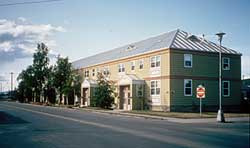
Ladd Field was established in 1940 originally as a Cold Weather Test Station at the insistence of Maj. Gen. H.H. Arnold, Chief of the Army Air Corps. Construction began in the fall of 1938. Named in honor of Maj. Arthur K. Ladd, killed in an aircraft accident in South Carolina in 1935, it was built just east of Fairbanks, Alaska. The first Army Air Corps troops arrived at the field in April 1940. Its World War II facilities were designed to fulfill three missions: cold weather experimental station, air depot for repair and testing of aircraft and the principle base in Alaska for the Air Transport Command. Here, at Alaska's first army airfield, vital lessons were learned in wing-icing, navigation, aircraft maintenance and operation, instruments and controls, radio communication, cold weather-clothing, armament and a wide variety of other investigations for operating aircraft in arctic-like conditions. As the Japanese prepared to invade the Aleutians in 1942, the 11th Air Force established an Air Depot at Ladd Field for the repair, testing and supply of aircraft in the Alaska Theater. Beginning in 1942, Ladd Field also became the center of the "Alsib (Alaska/Siberia) Movement," wherein nearly 8,000 military aircraft from the United States were transferred to Russian aircrews for use on the Russian Front, where the Soviet forces engaged the invading armies of Nazi Germany and its allies. Despite Alaska's harsh winters, this air-ferry route came to be preferred over the longer Miami-Iraq-Moscow route. Soviet diplomats and missions also traveled through Ladd Field during the enroute to and from the Soviet Union and the United States. A contingent of Soviet pilots landed at Ladd on September 24 to begin five days of training before flying the new airplanes home. The Americans wanted to deliver the airplanes to Siberia, but Joseph Stalin, leader of the Soviet Union, wishing to avoid an appearance of U.S.-Soviet collaboration in the Far East, suggested that the pilots pick up the aircraft in Alaska. The Soviet Union and Japan were not at war until the closing days of World War II, and the Soviets seemed to want to avoid any incidents that might incite the Japanese.

The first Air Corps troops arrived at Ladd Field in September 1940, and soon the first B-17 Flying Fortress arrived for experimental work. Cold weather-testing continued at Ladd Field until the spring of 1942 when concern over a Japanese invasion caused the Alaska Department to request the testing be halted. The 11th Air Force took over the field and established an air depot for aircraft repair, service and supply for the Alaska Theater. Within a few months, however, the commanding General of the Army Air Forces directed the reestablishment of cold weather-testing, which continued well after the conclusion of World War II. The establishment of the Air Depot at Ladd in 1942 resulted in the addition of nearly 1,000 officers and men to the garrison. Depot activities, combined with those of the Air Transport Command, resulted in the extension of the existing runway, construction of a second and the building of additional hangars and housing. The Air Transport Command took over Ladd Field in October 1943. By September 1945, when the Russian mission left Alaska, 7,930 aircraft had been delivered to the Soviets by way of the Alsib movement. On November 1, 1945, the Air Transport Command transferred Ladd Field back to the 11th Air Force. Fifteen years later, on January 1, 1961, the Department of the Air Force transferred Ladd Air Force Base to the Department of the Army. The Department renamed the now historic field Fort Jonathan M. Wainwright, for the heroic World War II commander of American forces of Corregidor in Manila Bay in the Philippines.

Because of the extremely cold winters in Alaska's interior, all buildings for the original garrison were permanent in nature. Officers' quarters are arranged in a horseshoe, centered on an open lawn. The huge, metal-clad Hangar No. 1 was the first to be completed at Ladd, in 1941. East, west and south of the hangar are extensive concrete or earthen aircraft parking areas where, later, airplanes destined for the Soviet Union received final preparation. Beyond them is the first of two parallel runways at Ladd Field. In 1941, this reinforced-concrete runway was 5,000 feet in length. By 1943, gravel extensions had been laid out at each end, giving a total length of over 9,000 feet. Two Kodiak, T-type hangars were erected at the end of the parking area east of Hangar No. 1. In 1943 three Birchwood-type hangars were authorized for the south side of the enlarged field. These nearly identical buildings are extant, and in good condition.
Visit the National Park Service Travel American Aviation to learn more about Aviation related Historic Sites.
Last updated: October 23, 2021
